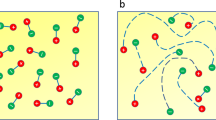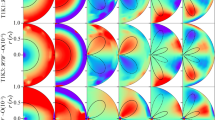Abstract
THE symmetry of the free Maxwell equations under transformation of electric field into magnetic field led Dirac1 to suggest the existence of magnetic monopoles. Many experimental searches for these particles have been made on different accelerators and using cosmic ray interactions; no magnetic monopoles having been detected, upper limits of the cross sections for the creation of monopoles have been obtained. The data of Ross et al.2 are the best and can be fitted by:  where σpn is the proton–nucleon cross-sections in cm2, and mg the monopole mass in GeV c−2. It is believed3,4 that very energetic particles are created in pulsars. These particles can interact between themselves and/or be smashed onto the neutron star surface to produce pairs of magnetic monopoles and antimonopoles. These monopoles (if they exist or are effectively produced) would be accelerated in the pulsar magnetic field, one species towards the interstellar medium, the other towards the neutron star, producing a decrease in the magnetic field. Such a phenomenon can be related to observations, particularly to the discrepancy between the characteristic and the kinematical ages. We show here that these observations can be explained by a production of magnetic monopoles, inherent to the pulsars, with a cross-section lower than equation (1), (that is, without contraction with the negative results of the terrestrial searches). More specifically, we will consider the magnetic monopoles production on the neutron star surface, in the Ruderman and Sutherland model4. Other models (with and without gaps) will be considered elsewhere.
where σpn is the proton–nucleon cross-sections in cm2, and mg the monopole mass in GeV c−2. It is believed3,4 that very energetic particles are created in pulsars. These particles can interact between themselves and/or be smashed onto the neutron star surface to produce pairs of magnetic monopoles and antimonopoles. These monopoles (if they exist or are effectively produced) would be accelerated in the pulsar magnetic field, one species towards the interstellar medium, the other towards the neutron star, producing a decrease in the magnetic field. Such a phenomenon can be related to observations, particularly to the discrepancy between the characteristic and the kinematical ages. We show here that these observations can be explained by a production of magnetic monopoles, inherent to the pulsars, with a cross-section lower than equation (1), (that is, without contraction with the negative results of the terrestrial searches). More specifically, we will consider the magnetic monopoles production on the neutron star surface, in the Ruderman and Sutherland model4. Other models (with and without gaps) will be considered elsewhere.
This is a preview of subscription content, access via your institution
Access options
Subscribe to this journal
Receive 51 print issues and online access
$199.00 per year
only $3.90 per issue
Buy this article
- Purchase on Springer Link
- Instant access to full article PDF
Prices may be subject to local taxes which are calculated during checkout
Similar content being viewed by others
References
Dirac, P. A. M. Proc. R. Soc A 133, 60–72 (1931).
Ross, R. R., Eberhard, P. H. & Alvarez, L. W. Phys. Rev. D8, 698–702 (1973).
Sturrock, P. A. Astrophys. J. 164, 529–556 (1971).
Ruderman, M. A. & Sutherland, P. G. Astrophys. J. 196, 51–72 (1975).
Kalman, G. & ter Haar, D. Nature 259, 467–468 (1976).
Taylor, J. H. & Manchester, R. N. Astr. J. 80, 794–806 (1975).
Taylor, J. H. & Manchester, R. N. Astrophys. J. 215, 885–896 (1977).
Author information
Authors and Affiliations
Rights and permissions
About this article
Cite this article
BONNARDEAU, M., DRUKIER, A. Creation of magnetic monopoles in pulsars. Nature 277, 543–544 (1979). https://doi.org/10.1038/277543a0
Received:
Accepted:
Published:
Issue Date:
DOI: https://doi.org/10.1038/277543a0
This article is cited by
-
Magnetic monopole field exposed by electrons
Nature Physics (2014)
-
A general relativistic model for magnetic monopole-infused compact objects
Astrophysics and Space Science (2012)
Comments
By submitting a comment you agree to abide by our Terms and Community Guidelines. If you find something abusive or that does not comply with our terms or guidelines please flag it as inappropriate.



